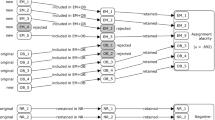Abstract
Differential effects of a particular small women's college environment on the attrition of its students were studied. Two separate entering classes, a total of 330Ss were classified into four categories, Persisters, Withdrawers, Academic Withdrawers, and Returners, and were compared on 35 personality and demographic characteristics, using as primary measures the 15 scales of the omnibus personality inventory. Conclusions, drawn from the data on persisters and withdrawers, were that: (a) no consistent differences appeared in demographic characteristics, (b) as hypothesized, students who withdrew were more complex and more autonomous, (c) the hypothesis that withdrawers would be more impulsive was not supported, and (d) as predicted, persisters differed from withdrawers on social introversion, intellectual disposition, and practical outlook. The study supports the thesis that important personality characteristics discriminate between persisters and withdrawers.
Similar content being viewed by others
References
Aiken, L. (1961). Prediction of academic success and early attrition by means of a multiple choice biographical inventory. American Education Research Journal 1(2):127–135.
Astin, A. (1972). College dropouts: A national profile. ACE research reports, vol. 7, no. 1, Washington, D.C.: Office of Research, American Council on Education.
Astin, A. (1964). Personal and environmental factors associated with college dropouts among high aptitude students. Journal of Educational Psychology 55:219–227.
Chase, C. T. (1965). The university freshman dropout. (Cooperative Research Project no. S-038), Indiana University and United States Office of Education.
Cope, R. G., Pauthorp, K., Trapp, D. C., Skaline M., and Hewitt, R. (1971). An investigation of entrance characteristics related to types of college dropouts. Educational Resources Information Center report no. ED 052 749, Washington University.
Douvan, E., and Kaye, C. (1962). Motivational factors in college entrance. In “The American College” (N. Sanford, ed.). New York: Wiley, pp. 199–224.
Duncan, O. (1961). A socioeconomic index for all occupations. In “Occupations and Social Status” (A. J. Reiss, ed.). New York: Free Press, pp. 109–138 and 203–275.
Eckland, B. K. (1964). Social class and college graduation: Some misconceptions corrected. American Journal of Sociology 70:38–50.
Feldman, K. A., and Newcomb, T. M. (1970). “Impact of College on Students.” San Francisco: Jossey-Bass.
Hannah, W. (1969). Drop out, Stay in personality differences. Dissertation Abstracts, 31:58A. (Abstract.)
Heilbrun, A. (1965). Personality factors in college dropouts. Journal of Applied Psychology 49:1–7.
Heist, P., and Young, G. (1968). “Omnibus Personality Inventory Form F.” New York: Psychological Corporation.
Iffert, R. B. (1956). Study of college student retention and withdrawal. College and University 31:435–447.
Knoell, D. (1966). A critical review of research on the college dropout. In “The College Dropout and the Utilization of Talent” (L. Pervin, L. Reik, and W. Dalrymple, eds.). Princeton, N.J.: Princeton University Press, pp. 63–110.
Newman, A. (1965). Study of college dropouts. (Cooperative Research Project no. S-130) Chicago: University of Chicago, Office of Education.
Pace, C. R. (1969). College and university environmental scales (CUES), technical manual. Princeton, N.J.: Educational Testing Service.
Panos, R., and Astin, A. (1967). Attrition among college students. Office of Research, American Council on Education 2(4).
Pervin, L., Reik, L., and Dalrymple, W. (1966). Personal determinants and their interaction with the environment. In “The College Dropout and the Utilization of Talent.” (L. Pervin, L. Reik, and W. Dalrymple, eds.). Princeton, N.J.: Princeton University Press, pp. 111–130.
Rose, H. (1965). Prediction and prevention of freshman attrition. Journal of Counseling Psychology 12:399–403.
Rose, H., and Elton, C. (1966). Another look at the college dropout. Journal of Counseling Psychology 13:242–244.
Slater, J. M. (1967). Perception: A context for consideration of persistence and attrition among college men. Personnel and Guidance Journal 35:434–440.
Stern, G. G. (1970). “People in Context.” New York: Wiley.
Summerskill, J. (1962). Dropouts from college. In “The American College:: (N. Sanford, ed.). New York: Wiley, pp. 627–658.
Trent, J. W., and Medsker, L. L. (1967). “Beyond High School.” Berkeley, Calif.: Center for Research and Development in Higher Education, University of California.
Vaughn, R. P. (1968). College dropouts: Dismissed vs. withdrew. Personnel and Guidance Journal 46:685–689.
Waller, C. (1964). Research related to college persistence. College and University 39:281–294.
Author information
Authors and Affiliations
Rights and permissions
About this article
Cite this article
Smith, D.G. Personality differences between persisters and withdrawers in a small women's college. Res High Educ 5, 15–25 (1976). https://doi.org/10.1007/BF00991957
Issue Date:
DOI: https://doi.org/10.1007/BF00991957




